In a new expedition, scientists uncovered over 27,000 barrel-like objects lying on the sea floor about 12 miles (19.3 kilometers) offshore Los Angeles, some still leaking toxic waste, scientists believe to be DDT.

In this 2011 image provided by the University of California Santa Barbara, a barrel sits on the seafloor near the coast of Catalina Island, California. /VCG
In this 2011 image provided by the University of California Santa Barbara, a barrel sits on the seafloor near the coast of Catalina Island, California. /VCG
In this latest survey, a team from the University of California San Diego's Scripps Institution of Oceanography used two deep-sea robots to map more than 36,000 acres (145.7 square kilometers) of seafloor between Catalina Island and the Los Angeles County coast over two weeks in March.

In this March 2021 image provided by Scripps Institution of Oceanography, researchers aboard the research vessel Sally Ride recover an autonomous underwater vehicle (AUV) after a search for discarded barrels near Santa Catalina Island, California. /VCG
In this March 2021 image provided by Scripps Institution of Oceanography, researchers aboard the research vessel Sally Ride recover an autonomous underwater vehicle (AUV) after a search for discarded barrels near Santa Catalina Island, California. /VCG

Researchers aboard the research vessel Sally Ride recover an autonomous underwater vehicle (AUV) after a search for discarded barrels near Santa Catalina Island, California. March 2021. /VCG
Researchers aboard the research vessel Sally Ride recover an autonomous underwater vehicle (AUV) after a search for discarded barrels near Santa Catalina Island, California. March 2021. /VCG

Researchers recover an autonomous underwater vehicle after a search for discarded barrels near Santa Catalina Island, California. /VCG
Researchers recover an autonomous underwater vehicle after a search for discarded barrels near Santa Catalina Island, California. /VCG

Research vessel Sally Ride is seen off the coast of Santa Catalina Island, California. /VCG
Research vessel Sally Ride is seen off the coast of Santa Catalina Island, California. /VCG
The size of the dumpsite turned out to be much bigger than expected: about the size of two Manhattans (Manhattan's land area is about 59 square kilometers), according to the Guardian. Los Angeles Times reports that scientists could find no end to the dumping ground after two weeks of surveying a swath of seafloor larger than the city of San Francisco.
LA Times also reports that for decades spanning from 1947 to 1961, "as much as 767 tons of DDT could have gone into the ocean." Shipping logs show that more than 2,000 barrels of DDT-laced sludge were dumped each month back then. However, the dumpsite had not been able to draw neither enough public attention nor government action, which the LA Times attributed to "decades of bureaucracy and competing environmental issues."
A local media report on Tuesday also noted that at one time dumping chemicals into the ocean was permitted by California and federal officials. Montrose Chemical Corp., which was described as the largest global supplier of DDT for decades, is estimated to have dumped 2,000 to 3,000 barrels a month from 1947 to 1961 - or about 1 million gallons (3.79 million liters) of waste per year.
Whether the finding of the latest expedition will translate into action this time remains to be seen.
Bloomberg reports that California lawmakers are now urging federal officials and Congress to act. On Thursday, the California State Assembly passed a resolution 70-0 calling for action. That resolution needs U.S. Senate approval to be forwarded to Congress.
Dichloro-diphenyl-trichloroethane (DDT) is a highly toxic insecticide that was once used widely throughout the world, primarily as an agricultural pesticide. A global ban on its agricultural use was ratified by more than 170 countries in 2004. But until today, it remains a WHO-recommended tool against diseases like malaria. Reports have linked DDT poisoning to breast cancer in humans and massive die-off in bird species, including falcons and bald eagles.
(All images by VCG)
(If you want to contribute and have specific expertise, please contact us at nature@cgtn.com.)

